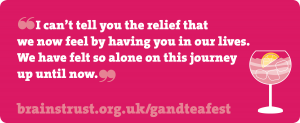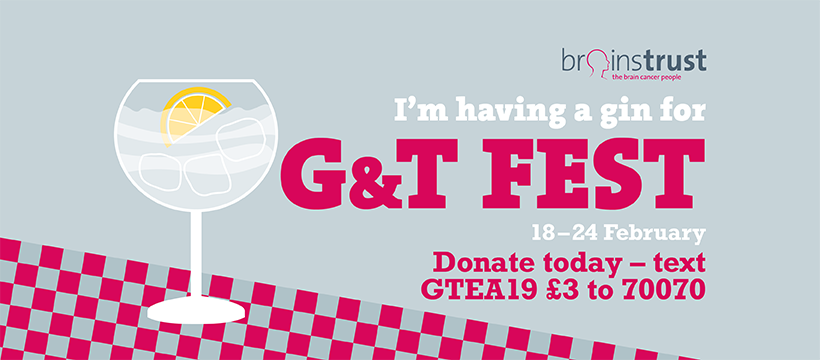
TEAFEST. IT’S BACK.
But this year, there’s strong competition!
 G&T Fest is the new kid on the block. Running alongside TEAFEST, it’s up to you to pick your drink of choice to help people living with a brain tumour.
G&T Fest is the new kid on the block. Running alongside TEAFEST, it’s up to you to pick your drink of choice to help people living with a brain tumour.
Whether it’s a cuppa or a G&T, having a drink with friends is one of life’s simple pleasures. And it is often taken for granted.
A brain tumour diagnosis is isolating: loss of mobility, fatigue and communication challenges are just some of the things that can make life with a brain tumour lonely.
So from Monday 18 – Sunday 24 February, whether it’s for a cuppa or a G&T, join us to let the 60,000 people living with a brain tumour know they’re not alone.
Tea or Gin – the choice is yours!
 TEAFEST is the annual fundraising and awareness campaign, where you have a cuppa and cake with friends, family and colleagues to drive the conversation on brain tumours.
TEAFEST is the annual fundraising and awareness campaign, where you have a cuppa and cake with friends, family and colleagues to drive the conversation on brain tumours.
However, we know that tea isn’t everyone’s drink of choice.
That’s why for 2019, we’re launching G&T Fest. With Gin now the nation’s favourite alcoholic drink, we know that lots of people prefer to meet up for a Gin and Tonic rather than a cup of tea. If you’re one of those people, you can sign up today and request your G&T Fest welcome pack.
Get your free welcome pack today
Whether it’s TEAFEST or G&T Fest which tickles your fancy, signing up is easy. Just fill in the form below, and tick which campaign you would like to support. We’ll send you the right welcome pack, full of fundraising and awareness tools that you need to make your event a huge success.
Encourage as many of your friends, family and colleagues to do likewise, and from 18-24 February, join us to see which campaign raises the most money to support people living with a brain tumour.
Donate
If you’d like to create a fundraising page for your TEAFEST or G&T Fest event, you can do so here.
If you’d like to make a donation, please go to brainstrust.org.uk/donate, call us on 01983 213 572 or text GTEA19 £3 to 70070. Your donations will help people living with a brain tumour feel less isolated and better supported.
Get kitted out for your event
No TEAFEST event is complete without the the TEAFEST mug, tea towel and tea coasters. You can order these by visiting our online shop. We also have a variety of merchandise, such as wristbands and pin badges, ready for you to buy and sell at your event, so that everyone can show their support to people living with a brain tumour.
Register for your fundraising pack today!
Each pack has stickers, posters, a collection box and inspiring resources to make raising awareness and vital funds for brainstrust easier than ever. So what will it be – TEAFEST or G&T Fest? Choose how you will take yours from 18-24 February, and show the 60,000 people living with a brain tumour that they’re not alone.
Your personal data is very important to us because it allows us to help people living with a brain tumour. Your details will only be used by brainstrust in adherence to our privacy policy. We will never give your information to other organisations without first seeking your specific consent. You can manage your mailing preferences at any time on this page
Got a question?
If you’re having problems registering for your welcome pack, or have a question about TEAFEST or G&T Fest, then please get in touch. Call us on 01983 213 576 or email ryan@brainstrust.org.uk.

Whether you’ve chosen TEAFEST or G&T Fest, we’ve created the perfect images for you to use on social media pages. Download the relevant profile picture and cover photo, share on Facebook, Twitter and Instagram, and encourage your friends and followers to do the same!

TEAFEST profile picture

TEAFEST cover photo

G&T Fest profile picture

G&T Fest cover photo

TEAFEST or G&T Fest email signature
As part of the first ever G&T Fest, we are delighted to be working alongside the following organisations:





